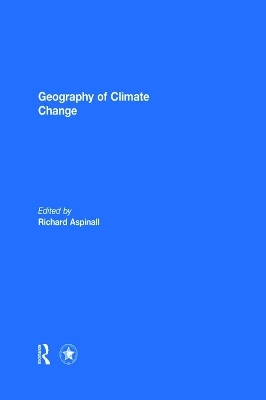
Geography of Climate Change
Routledge (Verlag)
978-0-415-69662-3 (ISBN)
This book was originally published as a special issue of Annals of the Association of American Geographers.
Climate change is one of the inescapable themes of current times. Climate change confronts society in issues as diverse as domestic and international political debate and negotiation, discussion in the media and public opinion, land management choices and decisions, and concerns about environmental, social and economic priorities now and for the future. Climate change also spans spatial, temporal and organisational scales, and has strong links with nature-society relationships, environmental dynamics, and vulnerability. Understanding the full range of possible consequences of climate change is essential for informed decision making and debate.
This book provides a collection of chapters that span environmental, social and economic aspects of climate change. Together the chapters provide a diverse and contrasting series that highlights the need to analyze, review and debate climate change and its possible impacts and consequences from multiple perspectives. The book also is intended to promote discussion and debate of a more integrated, inclusive and open approach to climate change and demonstrates the value of geography in addressing climate change issues.
This book was originally published as a special issue of Annals of the Association of American Geographers.
Richard Aspinall is a geographer with research interests in coupled human-environmental systems, especially in land use, environmental change, and ecosystem services, and in GIS. From 2006-2011 he was Director of the Macaulay Land Use Research Institute in Aberdeen, Scotland, an interdisciplinary institute addressing economic, social and environmental aspects of sustainability.
Part 1: Introduction 1. Geographical Perspectives on Climate Change Part 2: Articles 2. Beyond Adapting to Climate Change: Embedding Adaptation in Responses to Multiple Threats and Stresses 3. Changes in Annual Land-Surface Precipitation Over the Twentieth and Early Twenty-First Century 4. The Changing Geography of the U.S. Water Budget: Twentieth-Century Patterns and Twenty-First-Century Projections 5. The Columbian Encounter and the Little Ice Age: Abrupt Land Use Change, Fire, and Greenhouse Forcing 6. Climate Change and Mountain Topographic Evolution in the Central Karakoram, Pakistan 7. Climate Change and Tropical Andean Glacier Recession: Evaluating Hydrologic Changes and Livelihood Vulnerability in the Cordillera Blanca, Peru 8. Climate–Streamflow Linkages in the North-Central Rocky Mountains: Implications for a Changing Climate 9. Adapting to Climate Change in Andean Ecosystems: Landscapes, Capitals, and Perceptions Shaping Rural Livelihood Strategies and Linking Knowledge Systems 10. Making Sense of Twenty-First-Century Climate Change in the Altiplano: Observed Trends and CMIP3 Projections 11. Parameterization of Urban Characteristics for Global Climate Modeling 12. Climatic Shifts in the Availability of Contested Waters: A Long-Term Perspective from the Headwaters of the North Platte River 13. Climate Change, Drought, and Jamaican Agriculture: Local Knowledge and the Climate Record 14. Modeling Path Dependence in Agricultural Adaptation to Climate Variability and Change 15. Joint Effects of Marine Intrusion and Climate Change on the Mexican Avifauna 16. Adapting Across Boundaries: Climate Change, Social Learning, and Resilience in the U.S.–Mexico Border Region 17. Climate, Carbon, and Territory: Greenhouse Gas Mitigation in Seattle, Washington 18. Potential Impacts of Climate Change on Flood-Induced Travel Disruptions: A Case Study of Portland, Oregon, USA 19. Constructing Carbon Market Spacetime: Climate Change and the Onset of Neo-Modernity 20. Climate Change and the Global Financial Crisis: A Case of Double Exposure 21. Integrity of the Emerging Global Markets in Greenhouse Gases 22. Climate Change, Capitalism, and the Challenge of Transdisciplinarity 23. Contested Sovereignty in a Changing Arctic 24. Kiavallakkikput Agviq (Into the Whaling Cycle): Cetaceousness and Climate Change Among the Iñupiat of Arctic Alaska 25. Benchmarking the War Against Global Warming 26. Regional Initiatives: Scaling the Climate Response and Responding to Conceptions of Scale
| Zusatzinfo | 31 Tables, black and white; 57 Line drawings, black and white; 48 Illustrations, black and white |
|---|---|
| Verlagsort | London |
| Sprache | englisch |
| Maße | 219 x 276 mm |
| Gewicht | 1194 g |
| Themenwelt | Geisteswissenschaften ► Sprach- / Literaturwissenschaft ► Anglistik / Amerikanistik |
| Geisteswissenschaften ► Sprach- / Literaturwissenschaft ► Literaturgeschichte | |
| Naturwissenschaften ► Biologie ► Ökologie / Naturschutz | |
| Naturwissenschaften ► Geowissenschaften ► Geografie / Kartografie | |
| Naturwissenschaften ► Geowissenschaften ► Hydrologie / Ozeanografie | |
| Naturwissenschaften ► Geowissenschaften ► Meteorologie / Klimatologie | |
| Technik ► Umwelttechnik / Biotechnologie | |
| ISBN-10 | 0-415-69662-3 / 0415696623 |
| ISBN-13 | 978-0-415-69662-3 / 9780415696623 |
| Zustand | Neuware |
| Haben Sie eine Frage zum Produkt? |
aus dem Bereich


